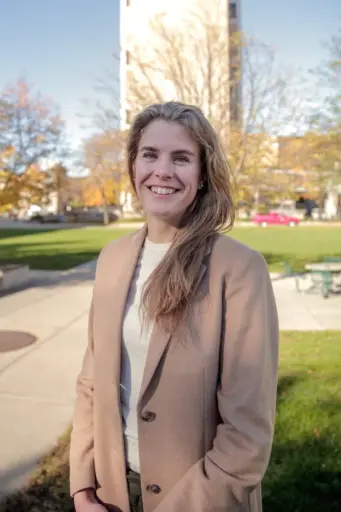During summer 2019, blackouts struck both Madison, Wisconsin, and Midtown Manhattan in New York, leaving thousands of people in each city without power for hours on end.
Both outages were set off by small-scale accidents that spiraled into major catastrophes; in New York City, a transformer fire around West 64th Street darkened the lights in Times Square, the Theater District and the Upper West Side, whereas an explosion at a substation along Madison’s East Washington Avenue left 12,000 people in and around the city’s downtown without electricity for the better part of a day.
 Line Roald
Line Roald
Blackouts can trigger additional chaos—for example, in both New York and Madison, people were trapped in elevators for hours and traffic lights went dark across each city. That’s one reason Line Roald, an assistant professor of electrical and computer engineering at the University of Wisconsin-Madison, is working to forecast disruptions before they happen, and in the process, help the power grid become more resilient.
“Rare, high-impact events are, by definition, difficult to predict,” says Roald. “We need to create new tools that can address uncertainty across several different scales.”
With support from the U.S. Department of Energy, Roald is developing new methods based on mathematical optimization that will help reliably deliver power, even when a catastrophe occurs.
It’s one of the DOE’s grand challenges for the 21st century, and Roald recognizes that the project is taking on increasing urgency.
“There’s evidence that the frequency of high-impact events like wildfires, floods and heat waves is increasing with climate change,” says Roald.
And disasters aren’t the only unpredictable factors that have the potential to disrupt the power grid. A main focus of Roald’s research is incorporating electricity derived from renewable sources, like solar and wind, into the energy infrastructure.
Renewable energy adds an added layer of uncertainty to the challenges of predicting rare, high-impact events. After all, the amount of available solar or wind power varies day by day and even hour by hour with the weather.
That’s why Roald’s ongoing research projects aim to help our power delivery system accommodate the inherent variability that comes with adding renewable energy into the grid.
Our modern grid usually distributes electricity in the form of so-called “three-phase power,” which is why transmission lines usually have a trio of wires strung from pole to pole. The three phases each represent staggered cycles of alternating electric current, which allows for constant power delivery.
Most appliances only need single-phase power to run, but large motors can take advantage of three-phase power to generate a rotating electric field. That’s why farmers and manufacturers often need to draw on three-phase power to run their heavy equipment.
When the current or voltage in one of the phases is out of balance with the others, motors and transformers may overheat and vibrate excessively.
And when an energy grid incorporates renewable power (for example, a rural neighborhood in which some of the houses have rooftop solar arrays), unbalances are expected to become more likely.
“It’s an important problem for agriculture,” says Roald. “Unbalanced voltage can cause motors to fail prematurely, and incur high cost for the customers.”
With support from the U.S. DOE, Roald has been working for the past year to develop optimization models to help the grid avoid unbalanced voltages as more and more electricity comes from renewable sources. It’s a project that is particularly important for farmers in rural Wisconsin and across the nation, as agricultural consumers frequently draw upon three-phase power.
Rural areas aren’t the only places that need reliable power: Big cities also must manage uncertainty when adding electricity from renewable sources into the grid.
And America’s largest metropolis, New York City, has tapped the expertise of Roald and Electrical and Computer Engineering Professor Giri Venkataramanan to help ensure continuous power delivery as more and more electricity coming into Manhattan originates from renewable sources.
In July 2019, Venkataramanan and Roald traveled to New York City to discuss the project with representatives from the New York Power Authority. As it turned out, the timing was serendipitous.
“We got back from New York just hours before the blackout,” says Roald. “It really drove home the importance of this research.”